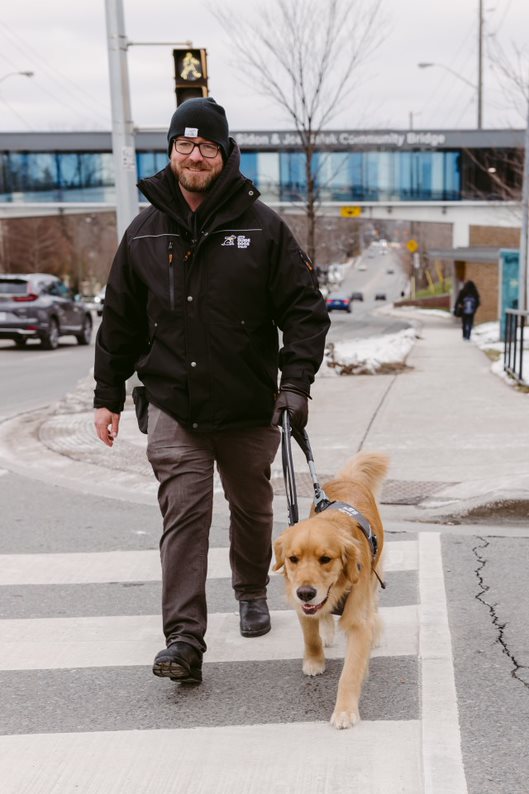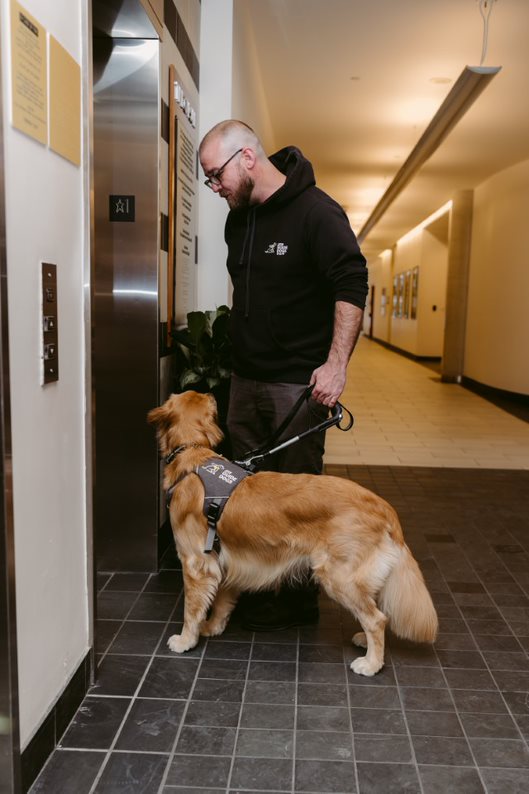In this special Q&A, Guide Dog Mobility Instructor Rob Cramer shares what your support makes possible at CNIB Guide Dogs.

First, please introduce yourself!
My name’s Rob Cramer – and I’ve been a Guide Dog Mobility Instructor (GDMI) at CNIB Guide Dogs since 2018.
What is a GDMI and how did you get into this work?
Part of my role involves training the dogs, teaching them the skills required to keep someone safe and to act as a guide dog. The other half of the role is matching a dog to an individual – I basically make dating profiles for both the dog and the handler – and then training that team together.
My mom is blind and she’s been a guide dog handler since I was 11. I remember meeting the Guide Dog Mobility Instructor and thinking, “That seems like a fantastic job!” I didn’t know it was a possibility then, but it was always in the back of my mind.
Before I was a GDMI, I got my start in the guide dog field in 2008 as a kennel attendant. I started a Guide Dog Trainer apprenticeship in 2009 before eventually becoming a Guide Dog Mobility Instructor.
Last time I checked, there were approximately 500 GDMIs in the world. Because it’s such a dream job, people don’t tend to leave it!
How does the guide dog matching process work?
A key part of the matching process is a three-hour in-home interview with the applicant where we look at every facet of their life to determine the right dog for them. That might come down to how much and how fast they walk, their dog-handling abilities, and the type of dog that will fit into their family life.
We then create a detailed report. When dogs are ready to be matched, it’s not first come, first serve. We try to find the best dog for the person as close to the top of the waitlist as we can find.
There’s some science to it, but there’s a lot of intuition and feel. People skills and the ability to read people are important. You have three hours to get a sense of who that person is. It’s challenging, but it’s critical you find the right match for the person or else it may not work out.
What does a typical day look like for you?
There’s no such thing as a typical day – that’s one of the best parts of this job! It depends on which phase of the role I’m working on. Right now, I’m working on guide dog training, so I’m picking up dogs, taking them out, training them. It’s quite active. We’re out in public finding training opportunities to maximize their potential.
Once dogs come to CNIB’s Canine Campus at 12 to 15 months old, they will work with a Guide Dog Trainer for three to five months. If they pass something called a blindfold standard assessment at the end of that period, they will move on to working with a GDMI, like me. Typically, I have them for eight weeks and I’m looking to match dogs after four weeks. During those first four weeks, I assess the dogs and try to identify a match. Then we can call the applicant and give them notice. During the last four weeks, I focus on tailoring that dog’s training to the individual’s lifestyle. For example, if the individual has a limp, I might simulate a limp with that dog. If someone lives in a rural area, I’ll tailor training with more rural roads. If someone is in a big city, I’ll be hitting up subways and busier environments.
Other times, I’ll be travelling across Canada to meet and assess applicants or doing follow-up interviews with handlers to support them.

How does CNIB support guide dog teams once they’ve graduated?
In the first year, we visit the teams at roughly six weeks, then six months, then the one-year mark. After that, it’s minimum once a year. Typically, if we’re travelling and in someone’s area, we’ll offer to stop in as well. If someone needs help or they need further support in addition to that, we’re obviously flexible and accommodating of that.
It’s not an assessment. It’s a support visit. The first thing I do is ask the handler what they want to work on. We want to support them and the dog and make sure they’re both happy, healthy, and safe!
What happens if a dog is not suited to guiding?
It depends on what stage they’re in. If they’re in formal training and they look like they’re not suitable to become a guide dog, that’s okay. We can look at two options: buddy dogs are paired with children and youth to get them used to being around a dog and to prep them for a potential guide dog partnership in the future. Ambassador dogs are often matched with CNIB staff or volunteers. They go out and promote CNIB Guide Dogs and the role of guide dogs in the community. If a dog is not suitable for any of our three career streams, we look at adopting those dogs out to members of the community.
What’s your favourite part of your job?
I love seeing a guide dog team start to work together – those incredible moments when they truly become a team. It’s special to observe because I get to work with the dog and the person separately before they’re matched. Once you put them together and start to see the bond forming and the dog taking responsibility for the person’s safety, it’s pretty neat to watch! It really fills me with pride.
I often say it takes a village to raise a guide dog – from Puppy Raisers to admin staff to the veterinary team to the people at Canine Campus looking after the dogs’ health and welfare. A lot of people make this result possible.
What’s something people find surprising about guide dogs?
I don’t think people often are aware of how much free time guide dogs get and how much they enjoy their jobs. While the dogs are professionals and have a job to do, they also get a lot of fun and playtime – both in training and with their handler. Work is only part of their life!
We give them enrichment – like toys, treats, and pool parties in the summer – so they get to enjoy life to the fullest just being a dog. In training, we use positive reinforcement techniques so it’s almost a game for them. And the biggest perk of all: guide dogs get to be with their person all the time unlike a typical pet. They absolutely love it!
What would you like to say to CNIB supporters and donors?
Thank you for your support! I’m fortunate enough that I get to witness the fruits of your contributions. I’m privileged enough to see where all your generosity leads to – it’s certainly worthwhile and a really special outcome you’re supporting. We couldn’t do our work without you.